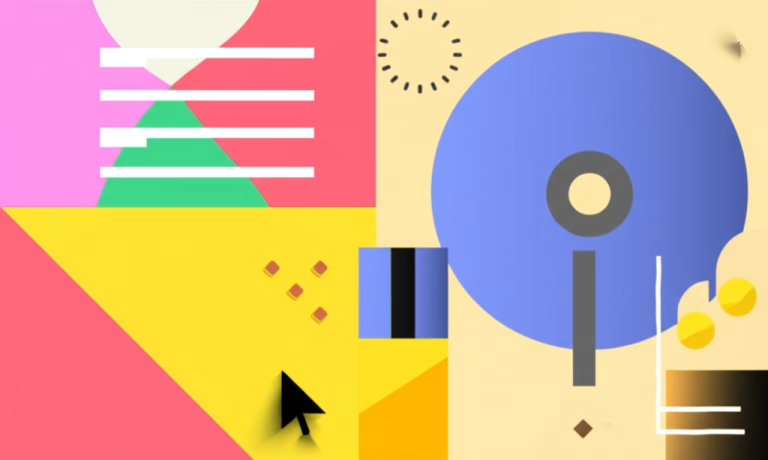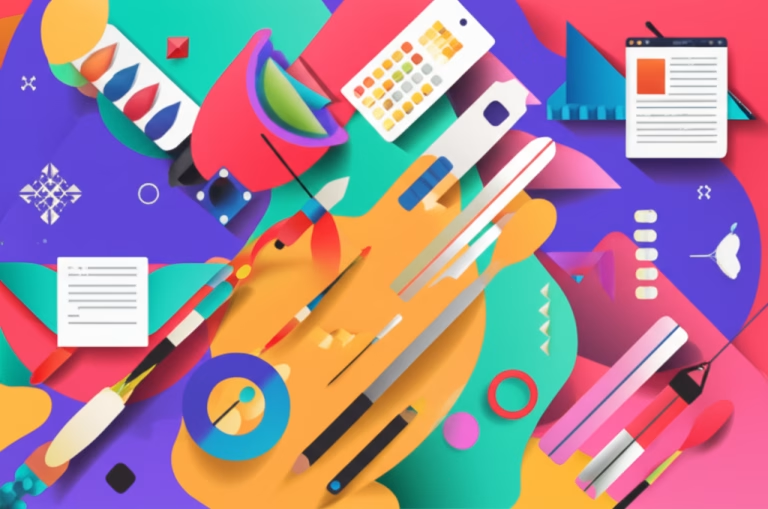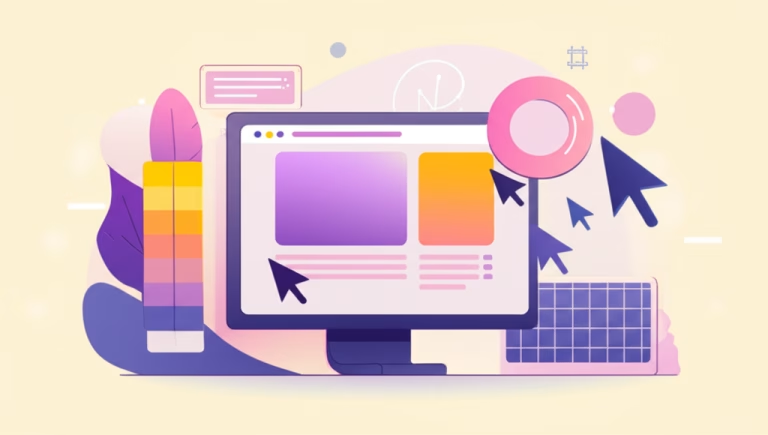Hello, future designers! Welcome to this comprehensive class, structured to provide those who are just starting out with an essential overview of the fascinating universe of Graphic Design.
The goal of this “Super Class” is not just to present concepts, but to inspire in everyone the desire to research more and understand the context in which we operate. Remember: design is not just art or inspiration; design is project and problem-solving, aiming for the perfect balance between form and function. When correctly applied, design solves problems functionally while providing aesthetic pleasure and usability.
We will structure our learning into fundamental, detailed modules, based solely on the insights shared in the source material.
Table of Contents
Module 1: Graphic Design History
1.1 The Essence of Design
Design is a way of solving problems, regardless of the vertical (graphic, product, interface, etc.). When you understand that design is planning and project development, the specific application becomes less important.
- Design vs. Art: Art is for expression or creating questions; design is born to solve a problem.
- Form and Function: Design is the bridge between form and function. A project is well-executed when these two elements are balanced, resulting in a good product or interface. A project can be functional but poorly resolved, like a charger that prevents the use of the mouse while charging. Aesthetics alone are not enough; beautiful and intelligent solutions are the goal.
- Design as Process: Design is a process, not an artistic gift or sudden inspiration. It involves breaking down a large problem into smaller pieces, which facilitates connections between problems and solutions, leading to innovation. Analytical and process-based thinking, provided by design, is crucial.
1.2 History and Key Movements
Studying history is essential because it provides timeless knowledge. Much of what is considered “new” today is a reinterpretation of past aesthetics.
| Period/Movement | Context and Contribution |
|---|---|
| Ancient Writing | The invention of cuneiform writing (c. 3100 BC) and money drastically changed society, enabling the registration of ideas, which propelled human cognitive evolution. |
| Printing Press | Invented in China (c. 1040 AD) and popularized in the West by Gutenberg (c. 1450 AD). This technology enabled mass printing, dramatically reducing the cost of books and increasing the scale of knowledge. |
| Industrial Revolution | Design, as a project linked to capitalism and production, was born here (late 1700s). The need for branding, marketing, and differentiation arose due to large-scale production and competition. |
| Arts & Crafts | A movement (c. 1870) that protested against the low-quality, soulless industrial production of the time. It advocated that objects should be useful and beautiful, valuing craftsmanship. |
| Art Nouveau | (c. 1890) Featured organic, vegetal forms mixed with metal and gold, influencing architecture and design. |
| Cubism | (c. 1900s) Questioned why images needed to be exact copies of reality, exploring geometric forms. |
| Bauhaus | The first widely recognized world design school (Germany, 1919–1933). Promoted a clean, functional, and clean aesthetic, advocating that form must follow function. |
| Pop Art | (c. 1950s–1960s) Brought the aesthetic of collage, vibrant colors, and comic book references, strongly influencing contemporary design. |
| Digital Era | (c. 2000s) With computers and Photoshop, Skeuomorphism emerged—the attempt to replicate physical objects (with texture, shine) in the digital environment. |
Conclusion on History: Everything we see today is a reinterpretation of things that have already happened.
Module 2: Semiotics and Perception
2.1 Semiotics: The Construction of Meanings
Semiotics is the study of how we interpret signs and codes and assign meaning to the world. For graphic designers, mastering semiotics is fundamental because our job is essentially to construct and assign meanings (in logos, identities, communication pieces, etc.).
The Semiotic Triad always involves:
- Object: The thing or idea we want to talk about.
- Sign: What represents that thing.
- Interpretant: The person who receives and decodes the communication.
The Sign can be categorized into three levels:
- Icon: Directly represents the object (e.g., a drawing of a flame for fire). It is recognizable by almost everyone, regardless of cultural repertoire.
- Index: Something that relates to or suggests the object (e.g., smoke for fire). It is a reference within the cognitive environment of the object.
- Symbol: A visual representation that symbolizes the object, but which may vary culturally (e.g., a Japanese Kanji for fire). Symbols require the interpretant’s repertoire to be decoded.
Strategic Application: Sophisticated design often uses the index or symbol rather than the obvious icon. The obvious solution (iconic) is not always the best strategic path; great brands (Nike, Apple, Coca-Cola) rarely represent exactly what they are. Communication occurs on multiple levels, and being literal is not necessary to convey the message.
2.2 Gestalt: The Source Code of Design
Gestalt is the study of how our minds perceive and organize shapes. It represents the rules or the “source code” of graphic design.
Principles of Perception (How the Mind Groups Forms):
- Pregnancy (Simplicity): The most important rule. Our brain interprets the whole before the parts (e.g., we see a dog, not just black dots). Pieces with high pregnancy are simple, clean, and highly identifiable, allowing the message to be decoded quickly. Low pregnancy creates visual noise.
- Closure: The brain automatically tends to close shapes, filling in missing information.
- Proximity: Elements close to each other are perceived as belonging to the same group or block. This is essential for establishing hierarchy in reading.
- Similarity: Objects that are similar (in color, shape, or form) are perceived as belonging to a unified group.
- Figure and Ground: Our brain can switch perception between the main image (figure) and the background (ground). This is important for deciding what should be highlighted (e.g., blurring the background to emphasize the figure).
Practical Composition Principles:
- Balance: The distribution of visual weight. Can be symmetrical (equal sides) or asymmetrical (different sides, but visually balanced).
- Alignment: Crucial for organizing content (left, center, right, or justified). Good alignment often relies on invisible grid lines.
- Contrast: The perceptible difference (in color, form, or size) between elements. High contrast generates hierarchy.
- Hierarchy: The visual order that directs the user to consume information in the desired sequence. You must tell the story one thing at a time.
- Emphasis: Making a part of the composition shine, often achieved through contrast, size, or strategic use of white space.
- Repetition: The basic principle of Visual Identity. Repeating elements creates visual consistency and consistency in a brand.
- White Space (Negative Space): The “air” in the design. Generous white space gives the composition time for cognitive rest and significantly increases the perceived value and sophistication of the central elements.
- Unity and Harmony: Ensures that all elements appear coherent and belong to the same system.
Module 3: Layout, Typography, and Color
3.1 Layout and Diagramming (Grids)
Grids are tools for building visual systems that ensure consistency, legibility, and easy interpretation.
- Grid Definition: A screen or grade made up of lines and columns (modular or column-based).
- Content First: The grid should be designed based on the content you plan to display, not the other way around.
- Margin: The essential white space around the entire layout, providing breathing room.
- Consistency and Rhythm: Grids help maintain alignment and organize content into “neat boxes,” giving rhythm to the piece. Designers should study grid logic, particularly using tools like Figma, which makes it easy to understand and apply column, gutter, and margin settings.
3.2 Color (Science and Psychology)
Color is a powerful element used to convey mood, sophistication, and codify signs and meanings.
| System | Use Principal | Principle | Primary Colors |
|---|---|---|---|
| RGB | Digital devices (screens, monitors) | Additive (emission of light) | Red, Green, Blue (sum results in white) |
| CMYK | Printing (physical) | Subtractive (addition of pigments/ink) | Cyan, Magenta, Yellow, Black (sum results in black) |
- Conversion: Converting RGB to CMYK results in a loss of color gamut, making printed images more opaque, as monitors display light-based colors that are often beyond the printer’s capability.
Color Relationships and Pantone
- Analogous Colors: Colors adjacent on the color wheel; they create harmony but low contrast.
- Complementary Colors: Colors opposite on the color wheel; they create high contrast, which is often desirable for emphasis.
- Pantone: A private brand that acts as a global reference for guaranteeing color consistency. When a designer specifies a Pantone code, it ensures the color is the same regardless of where it is printed, unlike colors that rely on ink mixtures (CMYK selection).
Color Psychology
Studying color psychology (e.g., based on the work of Eva Heller) is vital. Design decisions must be contextual and based on reasoning (the why). Color can immediately convey whether something is modern, luxurious (e.g., black and gold), or popular (e.g., bright red).
3.3 Typography (Anatomy and Optical Adjustment)
Typography is often called the “witchcraft” of design—a blend of mathematics and subtle optical adjustments.
- Terminology: Glyphs are the characters (letters, numbers); Font Family includes all weights (light, bold); Serif is the small foot/line at the end of some letters.
- X-Height: The height of the lowercase characters, which is crucial for legibility, especially in text blocks like books.
- Legibility Rules: A line of text should ideally contain between 45 and 75 characters (including letters and spaces); 66 characters is generally considered the ideal.
- Leading (Line Spacing): The space between lines. Too much or too little leading hinders reading. A good starting point for body text is 140–150% of the font size.
- Kerning vs. Tracking: Kerning is the specific space adjusted between two individual characters (often done by the typographer for optical perfection). Tracking is the uniform spacing applied across an entire word.
- Aesthetic and Meaning: Typography has an archetype and a personality. Changing the typeface changes the meaning; for instance, a script font does not convey “danger” like a serious, heavy font would.
- Optical Adjustment (Overshoot): To make rounded or triangular elements appear visually equal in size to square elements, they must slightly overshoot the baseline. This is a subtle visual adjustment, not pure mathematics, ensuring harmony.
Module 4: Methodology and Process
The Double Diamond (Double Diamond)
Having a design methodology is what distinguishes professionals. The Double Diamond, developed by the Design Council, is the most widely used structure. It is cyclical and divides the process into four main phases, alternating between divergent thinking (opening/exploring) and convergente thinking (closing/deciding).
| Phase | Dynamic | Main Action | Strategic Goal |
|---|---|---|---|
| 1. Discovery | Divergent (Opening) | Collecting the briefing, in-depth research, and information gathering. | Fully understanding the problem. |
| 2. Definition | Convergent (Closing) | Defining the exact problem and solution strategy. Crucially, this involves co-creation—presenting research and references to the client to align the project’s “compass”. | Gaining client alignment and shared responsibility before execution. |
| 3. Development | Divergent (Opening) | Ideation and creation of multiple possible solutions (drawing, prototyping). | Exploring creative possibilities based on the defined strategy. |
| 4. Delivery | Convergent (Closing) | Refining the best ideas and delivering the final solution. | Providing a solution aligned with the project goals. |
The Value of Process: The final art/design is only about 30% of the work; the other 70% is planning, strategy, research, and the why behind the decisions. Involving the client in the Discovery and Definition phases is key to approving projects and reducing rework, as they understand the value and share responsibility for the decisions made.
Module 5: Technology, Career, and the Future of Design
5.1 The Impact of Technology on Design
Technology is always tied to design (printing press, computers). Artificial Intelligence (AI) represents a new, massive paradigm shift.
- Beyond Image Generation: AI is a vast field (machine learning, neural networks, etc.) and is much broader than just image generation tools. Designers must understand how this technology works behind the scenes to stay ahead.
- Design as System Management: Design is moving toward system management. Designers should study Design Systems—modular identity models often built in tools like Figma, which incorporate system logic and tokenization.
- The New Role: The increasing capabilities of AI mean the technical, repetitive “grunt work” will decrease. The designer’s role shifts to that of the Curator—the maestro who orchestrates the production delegated to AI, maintaining the strategic perspective and meaning that the machine lacks.
5.2 Career and Future Skills
The World Economic Forum reports suggest that “traditional” graphic designer roles are among those that may decline due to automation.
- The Opportunity: While technology eliminates manual, repetitive tasks, there will always be a need for a designer to project the tool that performs the work.
- The Junior Challenge: Contraction of junior roles is observed, especially since the launch of tools like ChatGPT. Juniors are increasingly required to execute tasks previously done by entry-level staff, but seniors who master AI are now producing more efficiently.
- Required Skills: Designers must become T-Shaped specialists. You must be excellent in your core domain (design/aesthetics) but also acquire crucial core skills like analytical thinking, resilience, creative thinking, and technological literacy. New professionals must quickly adopt technological skills (automation, Python, AI systems) to generate immediate market value.
5.3 The New Paradigm: From Hour to Token
The future of design is rooted in scaling creativity and shifting the business model.
- Hyper-Personalization at Scale: Generative technology allows designers to create customized campaigns for specific audience niches—something previously financially impossible. A machine can write 1 million phrases in one minute, enabling individual-specific content.
- Abundance vs. Scarcity: Designers traditionally face a dilemma: more client deliverables mean less profit for the designer. With generative systems, the designer constructs the underlying workflow and asset generation system. The client can generate unlimited pieces (abundance), and the designer profits based on usage.
- The Token Charge: The business model moves from charging by the hour to charging by the token (for the consumed or generated asset). The designer focuses on system maintenance and scaling rather than piece-by-piece execution.
The industry is moving toward “living and generative brand manuals” (Design Systems) and providing small and medium-sized businesses with access to the high-quality production previously exclusive to large corporations. This abundance creates enormous market opportunities.



